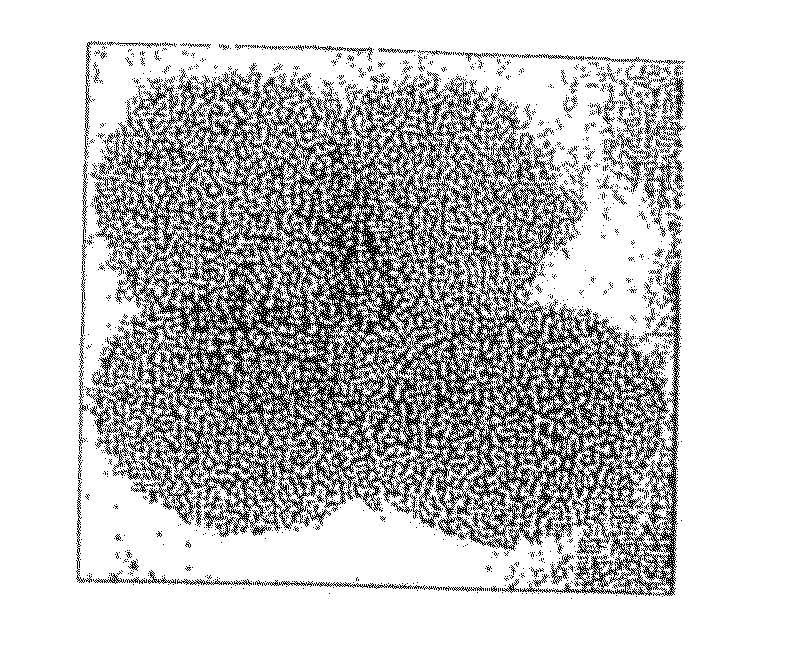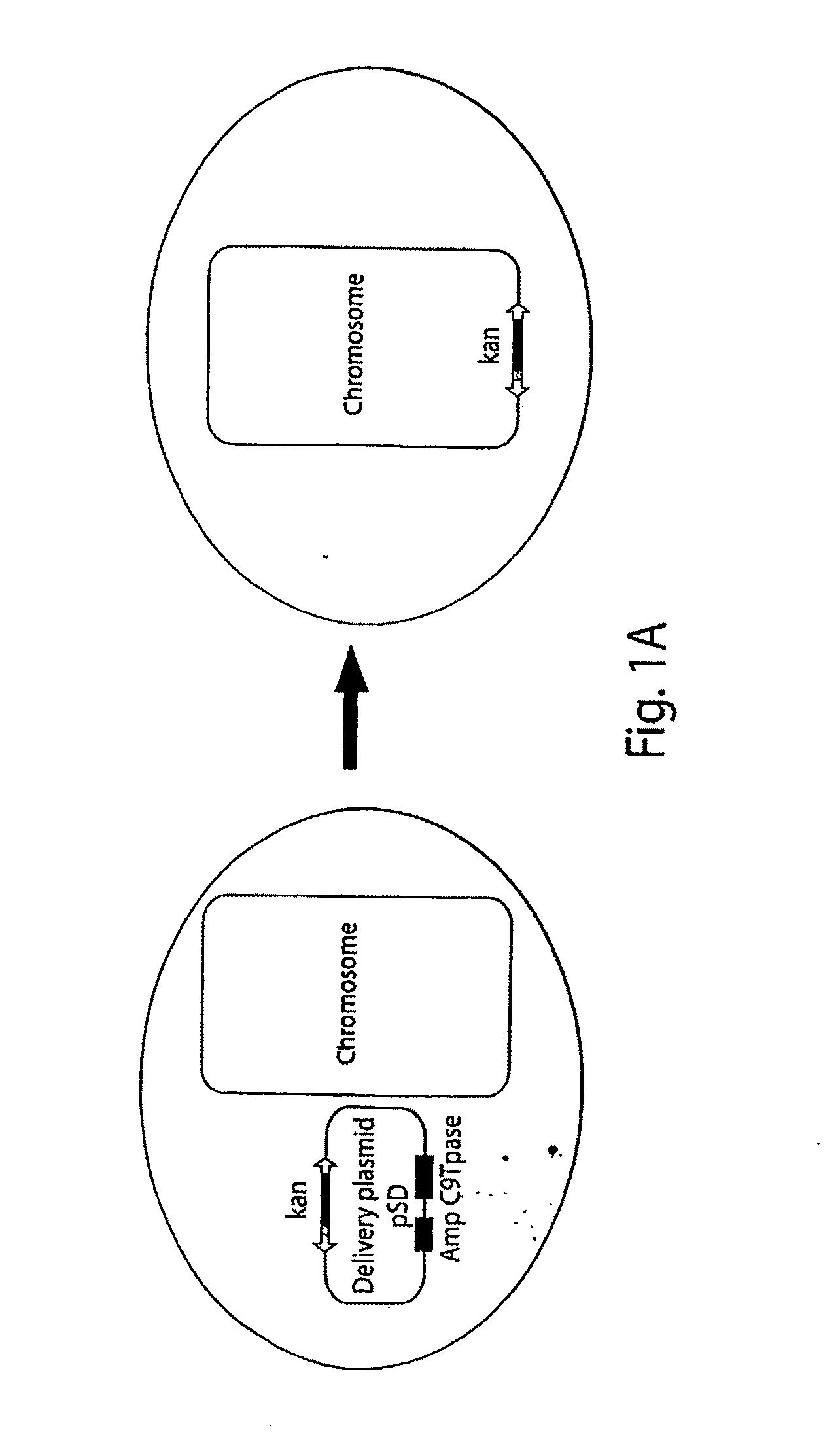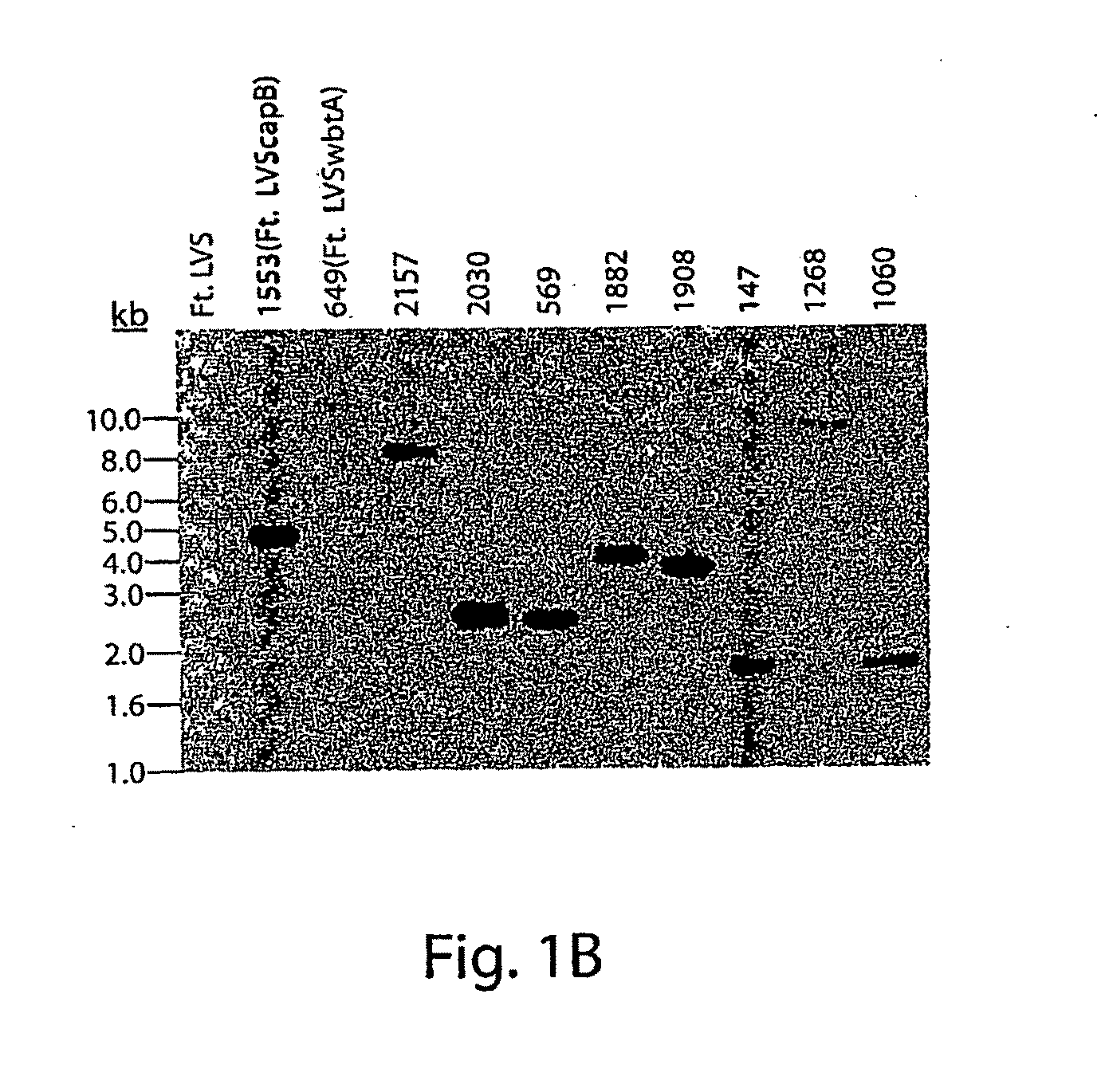Live Attenuated Vaccine Strain for Prevention of Tularemia
- Summary
- Abstract
- Description
- Claims
- Application Information
AI Technical Summary
Benefits of technology
Problems solved by technology
Method used
Image
Examples
example 1
Himar1 Transposon Mutagenesis of F. tularensis LVS and Identification of Polysaccharide Mutants
Materials and Methods
[0082]Bacteria and growth conditions. F. tularensis LVS (kindly provided by Dr. Karen Elkins, U.S. Food and Drug Administration, Bethesda, Md.) was cultured on cysteine heart agar supplemented with 1% hemoglobin (CHAR) for 72 hours (hrs) at 37° C. in 5% CO2. Colonies were grown in modified Mueller-Hinton broth (Difco, Detroit, Mich.) supplemented with ferric PPi and IsoVitaleX® (Becton Dickinson, Cockeysville, Md.). The doubling time of insertion mutants Ft. LVSΩwbtA and Ft. LVSΩcapB was compared to the parent strain in vitro using modified Mueller-Hinton broth following inoculation of the cultures at an approximate OD620 0.05. All growth experiments were performed in triplicate.
[0083]Construction of Francisella transposon. Mariner transposon constructs for the mutagenesis of F. tularensis LVS were constructed as follows. 1) To account for mariner insertions in both th...
example 2
Immune Electron Microscopy
Materials and Methods
[0092]Immune Electron Microscopy (IBM). Bacterial cultures were harvested from CHAH plates following a 72 hr growth at 37° C. in 5% CO2. The cultures were subjected to three washes to remove residual media component and resuspended in 1× phosphate buffered saline (PBS). 10 μl a of the suspension were spotted onto formvar-carbon coated copper grids and incubated for 30 minutes, followed by blocking for 20 min. in 0.5% fish gelatin (FSG) at room temperature (RT). The copper grids were then floated on 20 μl spots of primary antibody diluted in 0.5% FSG at a concentration of 1 / 20 for 30 min. at RT. Following incubation with primary antibody, the copper grids were washed by floating the grids on 1× PBS for 10 min. The grids were then incubated with the secondary antibody tagged with 15 nanomoles protein A gold (PAG) for 10 min. When using the mouse MAb 2033, an additional step using bridging antibody (rabbit anti-mouse) was performed prior t...
example 3
Biochemical Characterization of Himar1 Insertion Mutants
Materials and Methods
[0094]Outer membrane preparation. The bacterial pellet was suspended in a lysis buffer (0.05 M sodium phosphate, 0.15 M NaCl, and 0.01 M EDTA adjusted to pH 7.4), and incubated at 60° C. for 30 min. The suspension was subjected to mild shearing by passage through a 25-guage hypodermic needle by manual pressure and organisms were pelleted from the suspension by centrifugation at 12,000×g at 4° C. for 20 min followed by centrifugation of this supernatant fluid at 80,000×g at 4° C. for 2 hr.
[0095]Immunoblot Analysis. Outer membranes or bacterial cell lysates (10 μl) from each strain were suspended in 1× Laemmli sample buffer, heated at 100° C. for 10 min. and subjected to SDS-PAGE on a 4% -20% gradient gel. For immunoblot analysis, the bands were transferred overnight onto an Immobilon™-P transfer membrane (Millipore, Billerica, Mass.) using Towbin buffer (25 mM Tris-HCl, 192 mM glycine, 20% methanol). Followi...
PUM
| Property | Measurement | Unit |
|---|---|---|
| Time | aaaaa | aaaaa |
| Angle | aaaaa | aaaaa |
| Strain point | aaaaa | aaaaa |
Abstract
Description
Claims
Application Information
 Login to View More
Login to View More - R&D
- Intellectual Property
- Life Sciences
- Materials
- Tech Scout
- Unparalleled Data Quality
- Higher Quality Content
- 60% Fewer Hallucinations
Browse by: Latest US Patents, China's latest patents, Technical Efficacy Thesaurus, Application Domain, Technology Topic, Popular Technical Reports.
© 2025 PatSnap. All rights reserved.Legal|Privacy policy|Modern Slavery Act Transparency Statement|Sitemap|About US| Contact US: help@patsnap.com



